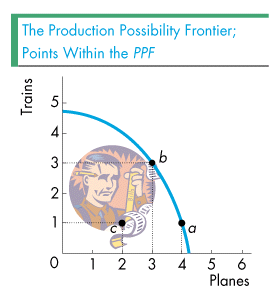Chapter 2
The basic idea of the PPF is that it shows the most output that can be produced. It's always possible to do less than the most. Thus if there is unemployment of workers, of capital, or of another factor of production, or if there is some other inefficiency, then the nation produces at a point within the PPF, such as point c in the figure. From a production point within the PPF, it is possible for the nation to decrease the unemployment of its factors of production or otherwise rearrange its production and thereby move to a point on (or closer to) the PPF. When this sort of change occurs, the nation can wind up producing more of all goods. For instance, the nation illustrated in the figure can move from point c where it produces 1 train and 2 planes to, say, point b on the PPF where it produces 3 trains and 3 planes. By eliminating unemployment or inefficiency, the nation produces 2 more trains and 1 more plane. Indeed, it is a hallmark of production within the PPF that it is possible to rearrange and produce more of all goods. From a point on the PPF, it is possible to increase the production of one product but only at the cost of decreasing the production of something else. Thus from point a on the PPF it is possible to move to point b and produce 2 more trains, but the cost of this change is the loss of 1 plane. In other words, moving along the PPF is possible, but there is always an for making a change. We've seen that it is possible - though probably not desirable - to produce within the interior of the PPF. How about beyond the PPF; is it possible to produce a combination of goods given by a point beyond the PPF? To find out, click the figure below. |
 It is possible
for a nation to produce at points within the interior
of the PPF. However, as the figure indicates,
points within the PPF are reached only when
there is unemployment of some factors of production
(such as the unemployed worker featured inside the PPF)
or some other sort of inefficiency.
It is possible
for a nation to produce at points within the interior
of the PPF. However, as the figure indicates,
points within the PPF are reached only when
there is unemployment of some factors of production
(such as the unemployed worker featured inside the PPF)
or some other sort of inefficiency.